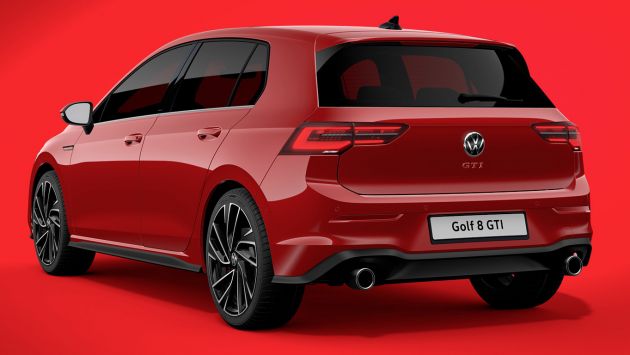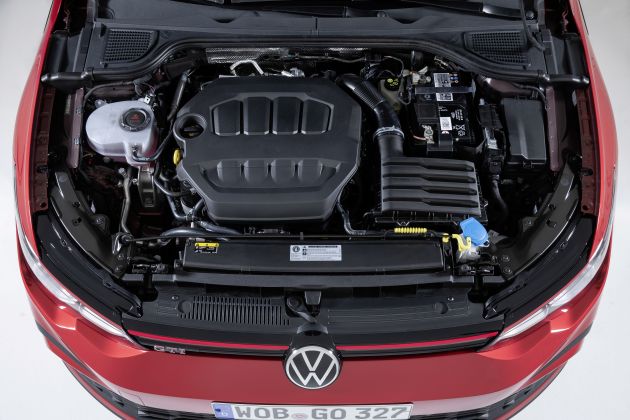In March, Volkswagen introduced the next chapter of the storied Golf GTI by unveiling the Mk8 model, and yesterday the company conducted an online press conference to reveal more details of the hot hatch, as it draws closer to its market launch.
Let’s start with the basics. The EA888 2.0 litre TSI turbocharged four-cylinder petrol engine – now in its fourth generation – carries over unchanged, but the uprated Performance variant is now the standard tune. With 245 PS and 370 Nm, it makes 15 PS and 20 Nm more than the regular Mk7.5 GTI, all routed to the front wheels through either a six-speed manual gearbox or a seven-speed DSG dual-clutch transmission.
Also lifted from the previous Performance version is the electronic locking differential, which now comes as standard. It joins XDS+ torque vectoring by braking and they’re all managed by a new Vehicle Dynamics Manager, a centralised controller that coordinates their functions.
The system also controls the Dynamic Chassis Control (DCC) adaptive dampers, which can adjust their settings up to 200 times a second based on the road conditions. Volkswagen says it has been able to completely eliminate understeer in the corners, partly due to the ability to significantly increase the differential’s locking torque in Sport mode.
There’s also a new Individual drive mode to complement the Comfort, Eco and Sport settings. Instead of using the presets, drivers can now adjust the DCC damping with a slider, which can now go beyond the Comfort and Sport modes for either maximum softness or stiffness.
The GTI is all about performance, of course, and Wolfsburg has sought to provide a more dynamic and predictable steer whilst maintaining the delicate balance between ride and handling. To that effect, the chassis – which still consists of MacPherson struts at the front and a multi-link setup at the rear – has been revised with new wishbone bushings, springs and front bump stops.
Spring rates have been increased all around, but more towards the rear – they’re up five percent at the front and 15% at the rear, giving the car greater agility and a better handling balance. The front subframe is also now made out of aluminium (first seen in the Mk7 GTI Clubsport) to shave off three kilograms in weight; it’s been optimised to provide maximum rigidity.
Also added is a “progressive” steering system with a variable ratio, which appears to have been lifted from Audi. Like the standard Mk8 Golf, the GTI features an electronic brake booster, but with bespoke tuning to provide more precise pedal feel close to the ABS activation zone.
All in all, Volkswagen says that the new GTI provides greater driving pleasure, with greater agility in tight low-speed corners and higher rear-end stability at higher speeds, plus more neutral steering and higher cornering grip. The company claims the Mk8 is four seconds faster than the Mk7 around Ehra-Lessein’s 3.3 km handling track, as well as being three kilometres per hour faster through slaloms and lane changes.
Unlike the past few generations, which utilised bespoke front bumper designs, the latest GTI wears the same body panels as the R-Line version of the cooking Golf, albeit with a few detail modifications. As before, the grille carries a red stripe that leads into the headlights, reaching all the way into the Mk8’s trademark “tails”.
The headlights feature LED illumination as standard and can be optioned with for IQ.Light matrix technology, while the grille can now be had with an illuminated strip for the first time, joining the LED daytime running lights. Speaking of lights, the GTI is available with X-shaped LED fog lights, housed within the honeycomb mesh of the full-width air intake. The latter is flanked by concentric black trim for a more aggressive look.
Along the side, the GTI-badged front fender insert has been retained, visually extending the headlight’s aforementioned “tails”. Black trim on the side skirts continue the look for the front splitter, while the wheels measure 17-inches for the standard Richmond units. Buyers can also specify 18- or 19-inch rollers, the latter with slightly wider tyres than before.
At the rear, you get a larger tailgate spoiler, a new centrally-mounted GTI badge and a deeper rear diffuser-like insert, housing real round tailpipes. The exterior additions are not just for show – the drag coefficient has lowered from 0.3 to 0.275, while lift has been reduced at the rear. Engineers added a bit of lift on the front axle, again in the interest of balance.
Subtle additions can also be found on the inside, with the meaty flat-bottomed three-spoke steering wheel getting a red accent on the bottom spoke and GTI badging. The sports seats continue with a tartan pattern on the inserts – now in a new “Scalepaper” design – and feature a bold red stripe around the headrest. Models with a manual transmission retain the golfball-style dimpled gearknob, also in a new design.
While other rivals like the Hyundai i30 N and Peugeot 308 GTI have become more aggressive in terms of design, Volkswagen has resisted giving the car a more extroverted look. Chief designer Klaus Bischoff said that a GTI owner will want to continue to show that they have a GTI, one that is stylish yet subdued. “Not too loud, not too silent,” he said.
The standard kit list in Europe includes the range-topping 10.25-inch Digital Cockpit instrument display with unique graphics and a centre rev counter, a 10-inch touchscreen for the navigation system, a 30-colour ambient lighting system, stainless steel pedals, keyless entry, autonomous emergency braking, lane keeping assist and car-to-x (vehicle-to-vehicle and vehicle-to-infrastructure) communication.
Source: Read Full Article




